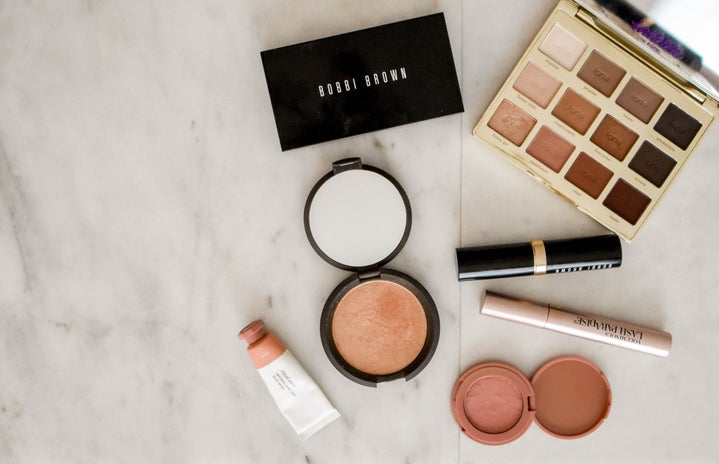Makeup is advertised everywhere. It’s on the television, it’s on every other page of a fashion magazine, and it’s on billboards. We don’t think about it that much. Oh, such and such company came out with 12 new matte, never come off your lips lipsticks or Oh, a new foundation that resists sweat that’s cool. No, not cool. I remember being at a Wanderlust festival in Tampa and there was a woman doing body art. She said she was using a type of paint made specifically for the body, and that it would come off later from all the sweat. “If it doesn’t come off with sweat or water, it’s not made for your body,” she said.
That statement couldn’t be truer. According to an article from Huffington Post, the average woman puts 515 synthetic chemicals on her body and has no idea. Not only is this an incredible amount of chemicals, but our skin absorbs 60 percent of those chemicals. There has been a huge crackdown of food companies using GMOs (genetically modified organisms), because they are unhealthy and artificial. Why would we let ourselves go out and buy beauty products that could harm us down the line? Hi, I’d like to buy a nice, liquid bottle of carcinogens please. Girl no, put that tube down it’s probably clogging your pores anyway.
I used to never understand why my mom would pick up makeup, read the ingredients, and then put it down immediately. What was so bad about foundation, mascara, or even sunscreen? Before I begin, I would like to point out that I am not a beauty professional, I am simply a concerned female who is looking out for others who are potentially using harmful products. This article is to go into detail about a few of the most common chemicals that are found in beauty products, and why consumers should stay away from them.
1. Parabens
According to Hello Glow, a website based on holistic beauty, the FDA has acknowledged studies that link parabens to breast cancer and skin cancer. Other parabens, such as isobutylparabens, can cause reproduction issues. While parabens are listed on makeup, shaving cream and shampoo products, they are not required to be listed on perfume bottles. The David Suzuki Foundation stated that, “Fragrance recipes are considered trade secrets, so manufacturers are not required to disclose fragrance chemicals in the list of ingredients.”
To avoid parabens, always check the labels and look for anything that ends in “-parabens”.
2. Fragrance
Going back on what was stated earlier about perfume, seeing the word “fragrance” means that you probably will not find all the ingredients on the back of that bottle. Hello Glow reported that the Environmental Working Group and the Campaign for Safe Cosmetics, “found an average of 14 chemicals in 17 name-brand fragrance products, none of them listed on the label.”
Stick to fragrance-free products so you know just what exactly you are spraying or lathering on your skin.
3. Oxybenzone
Even though sunscreen is supposed to be protecting your skin, it might not be doing you any favors in the long run. Oxybenzone is one of the most harmful ingredients in sunscreen, and has been linked to cause endometriosis in women.
Ladies, do your uterus a favor and stick to sunscreens with zinc oxide. This sits on top of your skin and starts to protect your from the sun’s rays as soon as you put it on.
4. Petroleum distillates
The first thing that came up when I typed this into Google was a definition from SAGE Solvent Alternatives Guides. It reads, “Petroleum distillates are hydrocarbon solvents produced from crude oil…” followed by, “Petroleum distillates are good for removal of heavy oil and grease, tar, and waxes.” This ingredient is found in many mascaras, so not only are women putting grease remover on their eyelashes, they are also putting themselves at risk of contact dermatitis and cancer-causing impurities.
Aside from these common chemicals, there is also BHA, BHT, siloxanes, PEG compounds, retinyl palmitate, retinol, aminophenol, triclocarban, triclosan, and sodium lauryl sulfate, just to name a few more. These can be found in shampoos, body washes, deodorants, makeup, toothpastes and moisturizers. The next time you go shopping, read the label and do yourself and your body a favor.
Photo credit: Pixabay


